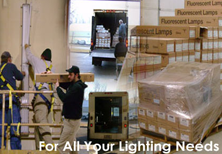Energy Saving Outdoor Lighting Solutions: Building Lighting

When it comes to reducing energy costs, one of the most commonly overlooked areas for improvement is outdoor lighting. This is because outdoor lights are often out of sight and out of mind during working hours, and even when they are noticed, business owners sometimes view them a necessity with little options. In reality, there is a large assortment of outdoor lighting products and, considering they often stay on throughout the night (and sometimes all day), choosing a high quality light can have a major impact on energy savings.
Because energy saving outdoor lighting is so important, we’re going to devote the next few blog posts to the top energy saving options. For today’s entry, we’re going to focus on building lighting — lights regularly attached to the exterior of buildings and on the ceilings of outdoor structures.
Wall packs
As their name suggests, wall packs are wall mounted lights, which are commonly seen on the outside of commercial and office buildings. They are one of the most widely used commercial fixtures and provide powerful lighting in outdoor applications. Not only can they physically withstand all types of weather, they are even capable of providing illumination in heavy snow, rain, and sleet. If you’re outfitting a building in a particularly harsh environment, it’s especially important to choose a wall pack with a durable housing and quality seals and gaskets.
Modern wall packs are designed with high intensity lamp heads that have a combination of energy efficiency, minimal light pollution, and durability. They are available in fluorescent, metal halide, high pressure sodium, induction and, LED lamp styles. Although all these options offer better efficiency and visibility as compared to mercury vapor or incandescent bulbs, today’s LEDs are arguably the best energy savers, with some yielding as much as a 75% reduction in overall energy consumption as compared to traditional systems.
Flood Lights
Flood lights are commonly used in conjunction with wall packs, and are frequently seen on warehouses, office buildings, parking garages, and other areas where a large amount of light is needed in a targeted area. Because they have such bright illumination, they are often the go-to choice for security and safety lighting — for both commercial and residential applications.
The most common types of flood lights currently on the market are incandescent, halogen, compact fluorescents (CFLs), and LEDS. Halogens have a higher lumen per watt ratio than incandescent and, therefore, offer a greater value in terms of energy efficiency.
But halogens still aren’t as efficient as CFL and LED outdoor lighting, which, in some cases, only use about half the power of a halogen. The good thing about both CFLs and LEDs is some of them can fit directly into existing incandescent or halogen fixtures, which means you can save on installation costs. Although more expensive than CFLs, many people are switching to LEDs because of their lack of mercury and other harmful substances (better for the environment). Plus, they are more durable, operate well in cold, outdoor environments, and their long lifespans ensures less overall maintenance.
Canopy
Canopy lights mount underneath surfaces, and are ideal for outdoor covered walkways, parking garage ceilings, convenience store canopies, underpasses, and other confined spaces. They come in a wide range of sizes and profiles and work with fluorescent, metal halide, high pressure sodium, LED, and induction bulbs.
Many commercial buildings, especially gas stations, make it their mission to have better illuminated establishments than their competition, since bright, eye-pleasing lights help to attract customers. With that in mind, it’s vital to pick bulbs that are not only energy efficient but also provide bright, crisp light that makes customers feel safe and welcome. LED canopy lights are often the preferred way to meet those needs, as they deliver the greatest of all available features: high illumination, low energy requirements, and long lifespans. Even if you have to convert an older system to accommodate LED outdoor lighting bulbs, the payback for such a project is usually short and delivers immediate positive results in energy costs and customer satisfaction.
Conclusion
No matter what combination of outdoor lights you choose, one of the quickest ways to save energy is by installing some type of control system which automatically turns the lights on and off when appropriate (i.e. programmed to turn on at night and off during the day). Buildings that carelessly leave outdoor lights on 24/7 waste a horrendous amount of energy and could see huge savings just by installing a time clock or photo controls.
When deciding whether or not to upgrade fixtures, many businesses analyze the trade-off between initial investment and long range energy savings. However, LED technology has advanced enough that in most outdoor lighting applications you can have the best of both worlds by opting for high-performance LED fixtures.



Good Day.
Lake Club Apartments is a high rise block of apartments. we are calling for quotations for interior lighting.
Please contact me to arrange a site meeting.
Nigel Ellerbeck 072 820 7426
We need to get a quote for retrofitting our outdoor lighting also